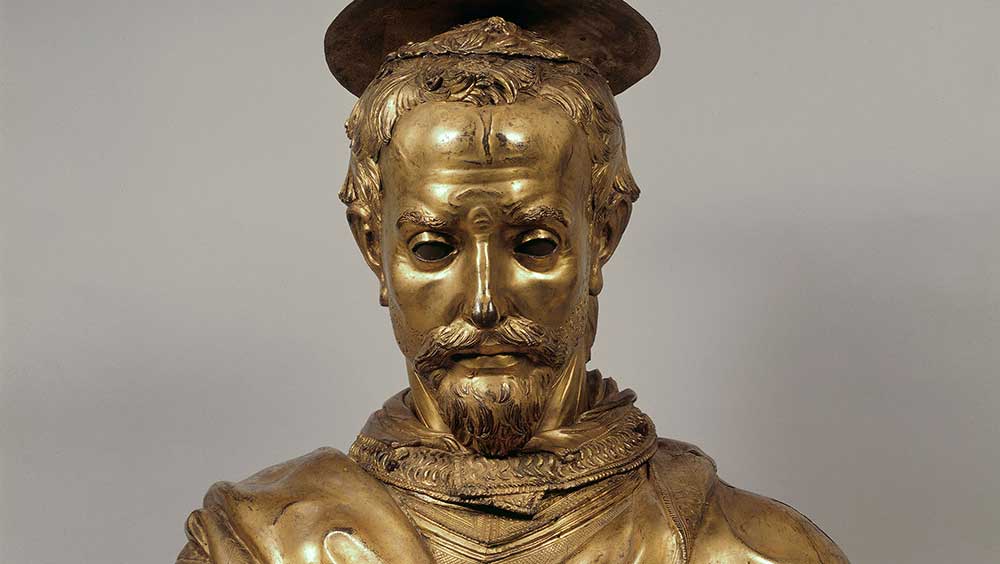
Donatello, San Rossore, by permission of the Ministry of Culture - Regional Directorate of Museums of Tuscany, Florence.
V&A South Kensington, London
11 February – 11 June 2023
by TOM DENMAN
It is striking, menacing even, how the sculptures of Donato di Niccolò di Betto Bardi (c1386-1466), better known as Donatello, disrupt the teleological view of the history of Italian Renaissance art as a steady progression towards recreating the artistic perfection of ancient Greece and Rome. As this exhibition reveals, what defines the temporality of the Florentine sculptor’s work is less a triumphant revival of classicism than a negotiation. He looks backwards to the near, medieval past, as well as forwards (via the rebirth of antiquity), defying the mythic image of the Renaissance artist forging ahead. Often, it is the strange, inherent medievalism in his work – and perhaps even a slight ambivalence towards antiquity – along with a striving to convey emotion above all things, that makes it so intensely affective and enduring.
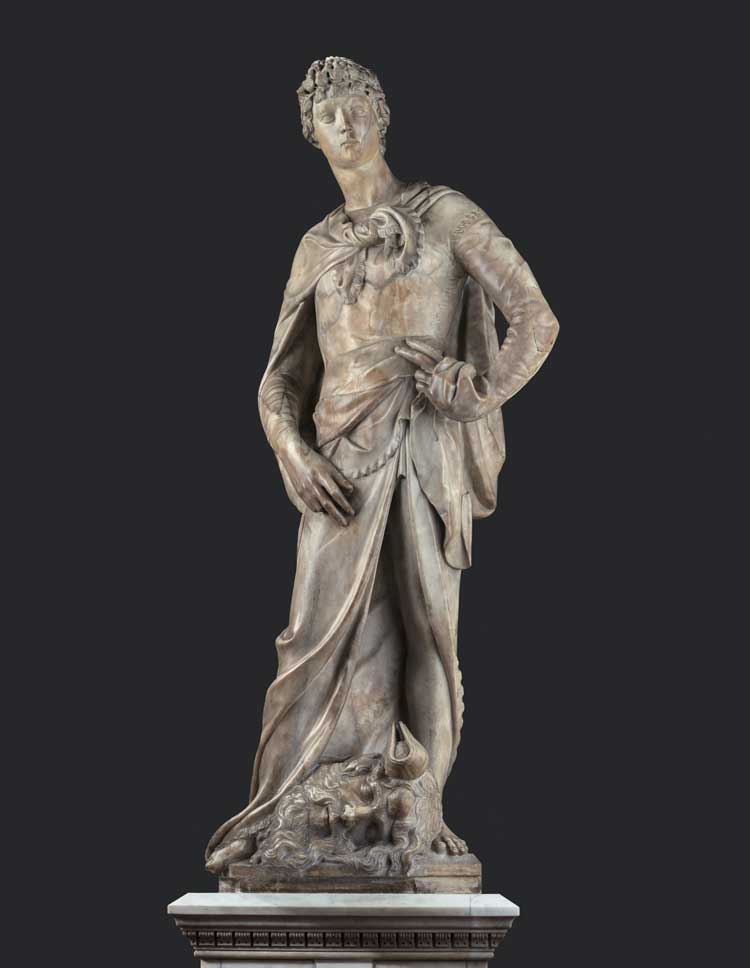
Donatello, David, Museo Nazionale del Bargello, Florence, courtesy of the Ministry of Culture. Photo: Bruno Bruchi.
Greeting us is Donatello’s first statue of David (c1408-09; modified 1416), in marble, which he began in his early 20s. Less famous than the virtuoso bronze version he made three decades later (a 19th-century copy of which is included here), it still captivates, its so-called “Gothic sway” embodying the youthful pride of subject and maker. As an emblem of dexterity winning over brute strength, it is a fitting opener to an exhibition dedicated to the intricacies of fine craftsmanship. Other than the precocity of David’s demeanour, it is the details that draw attention: the stitching on his tunic, the toes of his right foot curling over the edge of his pedestal.
What follows is a tapestry of Donatello’s life and legacy presented through a range of objects. That less than half of these can be certainly attributed to the sculptor’s hand is not to the show’s discredit, especially with the understanding that many of Donatello’s most famous works are in situ and unmovable, or too precious to travel. Furthermore, the curation’s contextualising approach anchors the exhibition in practice as much as wonder – we learn what it was like to be a sculptor in 15th-century Italy. Although smaller in scale than the version in Florence last year, the exhibition is arguably more intimate because of it, inviting us to join the dots, and drawing us closer to the works and the time.
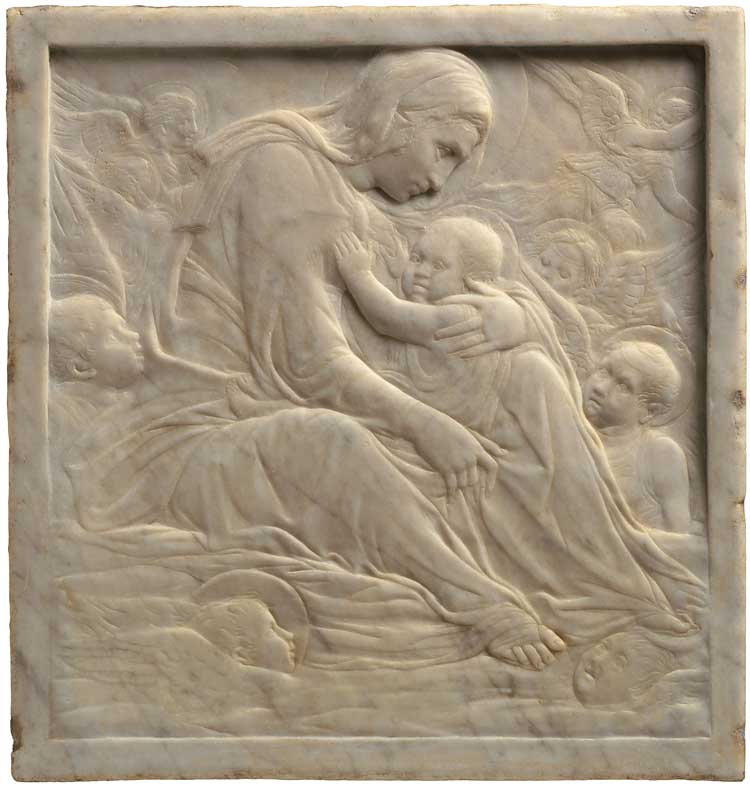
Donatello, Madonna of the Clouds, Photo: © 2023. Museum of Fine Arts, Boston.
There is an attempt to introduce us to the sort of work Donatello would have produced while training as a goldsmith in Lorenzo Ghiberti’s workshop – such as, for instance, Ugolino di Vieri’s beautiful enamelled plaque depicting the Annunciation (c1320-40) – since no examples of his own goldsmithing survive. But the exhibition’s format is mostly thematic, rather than chronological. The inclusion of gilded items illustrates the porosity between the decorative and fine arts, conjoined because it was customary, if not necessary, for sculptors to train in both. They come together to outstanding effect in Donatello’s so-called Piot Madonna (c1440), a terracotta tondo, the background of which is inlayed with medallions of red and white wax, each with a cherub or amphora motif, thus also unifying the taste for antiquity with the artist’s incorporation of a medieval aesthetic in the Virgin’s proportions and intense facial expressivity.
The show’s clustering acquaints us with Donatello’s collaborative practice. Hence we often see works in multiple, such as three small reliefs of the Virgin and Child (c1425-40; c1430-50; c1435-40), in copper, bronze and stucco respectively, all executed by different hands following one of Donatello’s designs. Such sequences offer a sense of the sociability and economy of sculptural practice in the 15th century, when ideas shifted between hands and workshops. A magnificent collaboration is the capital (1433) that Donatello made with the assistance of Michelozzo di Bartolomeo for the pulpit of Prato Cathedral. It is all the more moving for being displaced from its context, and because the gilding has almost completely worn away from the bronze. With the work stripped bare and brought closer to us in this way, we can appreciate the human tactility and asymmetries of its making, and the emotive naturalism of the figures populating the design – it is both staggeringly grand and imperfectly intimate.
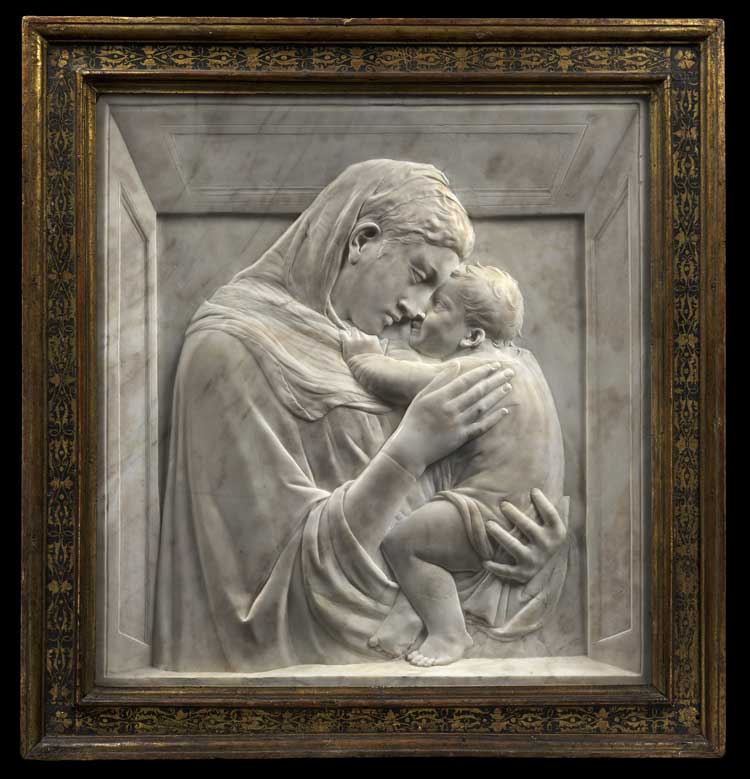
Donatello, Pazzi Madonna, Skulpturensammlung und Museum für Byzantinische Kunst der Staatlichen Museen zu Berlin. Photo: Antje Voigt, Berlin.
Giorgio Vasari, the 16th-century critic who authoritatively theorised the re-classicising trajectory of Italian Renaissance art, opined that no none surpassed Donatello in the art of relief sculpture, particularly the rilievo schiacciato method, which involved keeping the surface so flat that it appears almost as if it were minted like a coin. The show includes some stunning examples, one of which is the Pazzi Madonna (c1420-25). Donatello uses rilievo schiacciato to emphasise this maternal-filial intimacy in a metonymic way – the fineness of the relief is also their faces’ proximity, just as their overlap is their touch, and their dissolving into each other. The modelling of the baby’s cheeks, the way the Virgin’s fingers press into his flesh, and the overall lightness of touch make the image feel natural, and yet it is hardly an “accurate” representation. It hints at realism while also transcending it, as both depiction of mother and child and platonic idealisation of divine love.
Putting Donatello side by side with so many other artists brings out his idiosyncrasies. Although it is clear from the Prato capital, as well as the use of perspective and the friezelike multifiguration in the Miracle of the Mule (c1446-49), the equally intricate Forzori Altar (c1450), and his inventive cherubs – known as spiritelli – that he was adept at recreating classical forms, he seems to have been less adamant about pursuing this ideal than his contemporaries, older and younger. He departed from Ghiberti’s reticence, evidenced here in a bronze reliquary adorned by two angels (c1422-27). Donatello’s protégé, Desiderio da Settignano, is said to have been closest to him at mastering the rilievo schiacciato technique. But in his Panciatichi Madonna (c1453-60), he has compartmentalised Donatello’s teachings, drawing from his technical mastery while dispensing with his aesthetic to align himself more solidly with the ideology that defined the era.
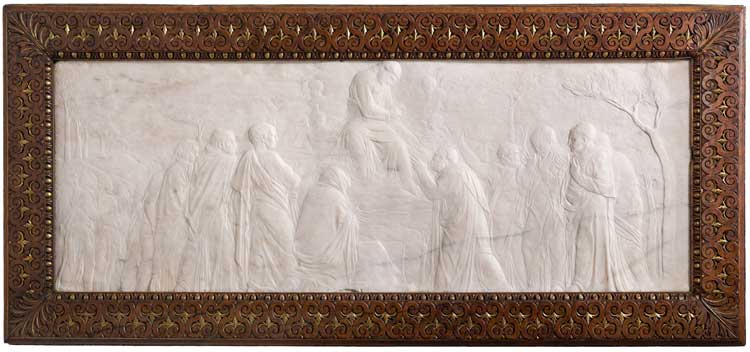
Donatello, Ascension with Christ giving the keys to St Peter. © Victoria and Albert Museum, London.
There is also something uncanny about Donatello. His Crucifix (1444-49) is moving less because of the graceful rendering of the whole than the strange protrusion of ribs that breaks with it and the loincloth blowing in the wind. Both details, the first of which is anatomically inaccurate – the ribs forming a semi-circular, articulated arch – work in tandem. The bones accentuate his emaciation for which the threadbare cloth is a metonym, and these together symbolically elicit Christ’s suffering. Ingeniously, Donatello has sacrificed realism and classical perfection for expression. Also strange are the spiritelli Donatello invented – resembling putti or cherubs, though arguably more vivacious, and unnerving in their anthropomorphic oddity. In a statement of virtuosity and invention, Donatello has modelled their wings with the feathers growing seamlessly from their shoulders and backs like a layer of reptilian scales you could peel off.
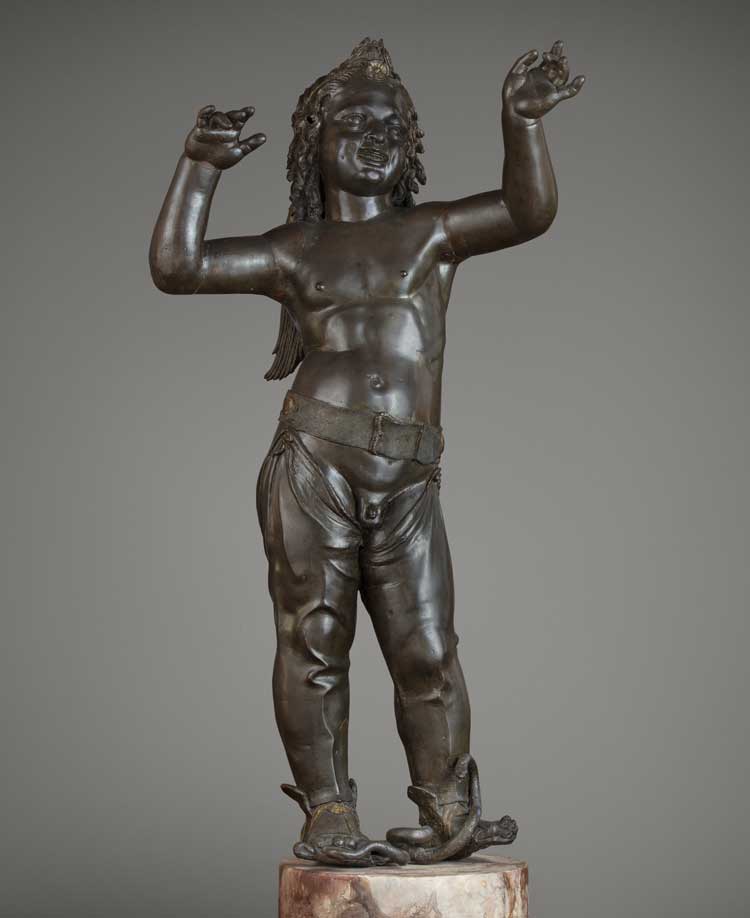
Donatello, Attis-Amorino, Museo Nazionale del Bargello, Florence, courtesy of the Ministry of Culture. Photo: Bruno Bruchi.
The clue to Donatello’s particular sensibility is found in his intermedial dialogue with painting. In an instructive coupling, Donatello’s bronze relief, Dead Christ with Angels (1449), is placed beside Giovanni Bellini’s painting of the same subject (c1465). Although the painting came later – Bellini probably studied the relief in the Basilica of Saint Anthony in Padua – the comparison brilliantly highlights the painterliness of Donatello’s mode of expression. That painting had yet to fully assimilate the curvilinear grace and muscularity of antique sculpture (which constituted most examples of classical art) might partly explain Donatello’s persistent undercurrent of Gothicness. Neither work holds back, but while Bellini has sought a realistic rendering of Christ’s dead face – his mouth gaping as if he had literally breathed out the ghost – Donatello has foregone realism for chiselled serenity, which he contrasts with the tears and wails of the angels.
It ends with a section dedicated to his legacy, including a fine posthumously cast figurine of David with the Head of Goliath (c1460s-70s), which could have been from a wax model by Donatello, and imitations or works bearing signs of his influence from the decades following his death and from the 19th-century Renaissance revival. However, one thing that struck me in this exhibition was the modernity of Donatello’s reliefs, whose pared-down, angular vitality reaches yet further forward, placing him not uncomfortably among sculptors of the early 20th century. And while his challenge to dominant temporalities – along with his “refusal” – does not exactly make him contemporary, it could give him contemporary relevance. To encounter Donatello is to enter a frenetic time warp, jumping between pasts and presents, near and far.